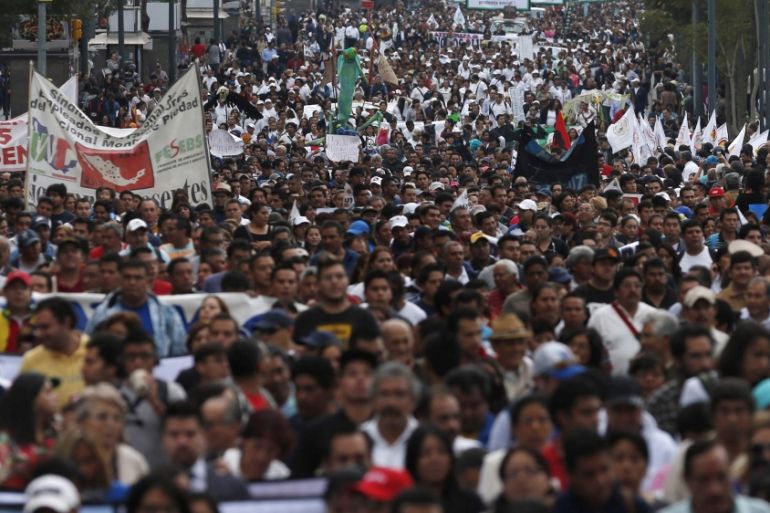Argentine experts query Mexico missing students results
Forensic team says Mexican government’s conclusion that 43 students were killed and burned is not supported by evidence.

Argentine forensics experts have questioned Mexico’s investigation into the disappearance of 43 students, saying the evidence does not support the government’s conclusion that the youths were killed and burned to ashes.
The Argentine Forensic Anthropologists team, hired on behalf of the victims’ parents as an independent party, on Saturday issued what it said was a list of discrepancies in the case. The team had access to forensic evidence and crime scenes along with federal prosecutors and Mexico’s own forensic investigators.
Keep reading
list of 4 itemsColumbia University leaders face scrutiny over anti-Semitism on campus
Top USC graduate cancelled over Gaza speaks out
Columbia president faces anti-Semitism Congress hearing: What’s at stake?
Its statement said Mexico’s government presented biased analyses of the scientific evidence to support its conclusion that the bodies of the college students were burned to ashes in Cocula in southern Guerrero state and their remains thrown into a river to hide the evidence.
So far only one of the students has been identified from charred remains found at the river.
The team “would like to reiterate that it doesn’t exclude the possibility that some of the students met the fate described by the attorney general”, the experts said in the statement issued after they met with parents.
“But in our opinion there is no scientific evidence to support that in the Cocula garbage dump.”
INSIDE STORY: Who is responsible for Mexico’s missing students?
The attorney general’s office did not immediately respond to requests for comment on the statement from the Argentine team, a non-profit forensic science organisation that investigates human right violations around the world.
Attorney General Jesus Murillo Karam said on January 27 that based on 39 confessions, 386 declarations, 487 forensic tests, 16 raids and two reconstructions, authorities had concluded that municipal police arrested the youths in the city of Iguala on September 26.
The students were then allegedly handed over to the Guerreros Unidos cartel, which killed and burned them into the next day in a huge pyre and disposed of the ashes.
|
|
Many groups inside Mexico and abroad have questioned Karam’s conclusion as implausible, including that the temperature of an open-air fire could reach that of a crematorium oven and turn 43 bodies to ash.
According to the Argentine team’s statement, there was satellite evidence of many fires at the same dump in the last four years.
Multiple mistakes
The team found human remains at the dump that did not belong to the students, including a tooth belonging to a set of dentures. None of the students wore dentures.
The team noted the attorney general’s office made mistakes in 20 genetic profiles collected from family members of the 43 students that made them unusable for DNA matches.
It said such errors are unusual as the process of collecting material is simple.
The prosecutor’s office also allowed the dump, a key crime scene, to go unguarded for several weeks, permitting anyone to plant or manipulate evidence, the team said.
Karam’s January news conference was seen as an effort by the government to finally close the case, which has caused significant political turmoil inside of Mexico and protests at home and abroad.